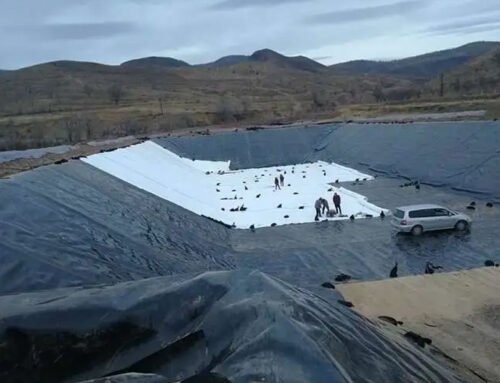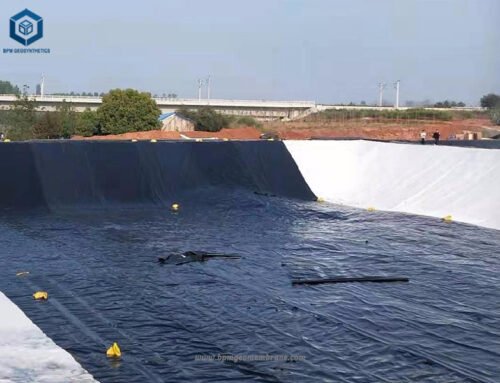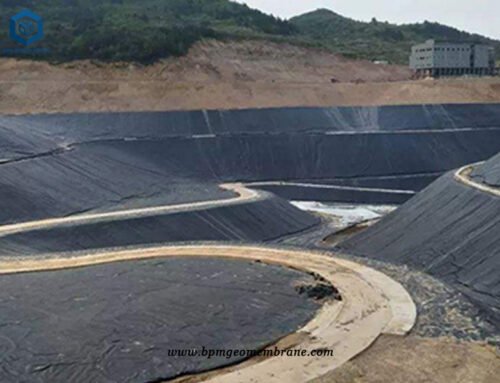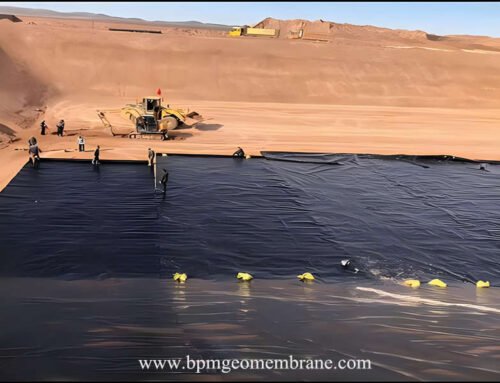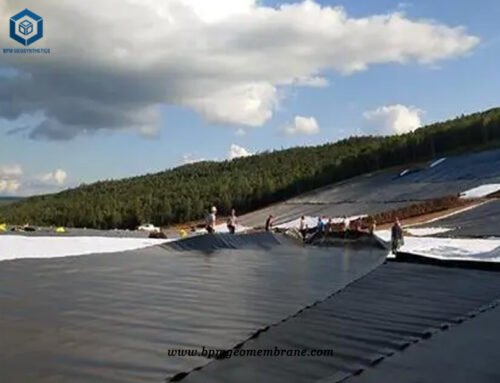Best pond liner material is crucial for preserving water quality and pond integrity while achieving a balance between cost and performance. It helps prevent water loss, maintains proper water levels, and safeguards against contaminants entering or leaving the pond. BPM Geomembrane is the pond liner manufacturer and supplier, we wholesale geomembrane liner with complete size and thickness at great factory price. Compared with PVC, EPDM or LDPE liner, HDPE liner ranks the best pond liner materiral due to its durability, chemical, UV and punture resistance, and more.
1. What is Best Pond Liner Materials?
Best pond liner materials are essential for creating a reliable and watertight barrier in ponds or water features, whether for water storage or waste containment purposes. These specialized liners are designed to prevent water seepage and maintain the water level, providing an environment suitable for water or waste storage.
Typically, the best pond liners are made from durable and flexible materials such as EPDM (ethylene propylene diene monomer), PVC (polyvinyl chloride), or HDPE (high-density polyethylene). Each material offers its own advantages, including UV resistance, puncture resistance, and flexibility. The choice of the best pond liner material depends on factors such as pond size, application type, and individual preferences. Among these options, HDPE is often considered the top choice due to its exceptional durability and strength.
Best pond liners are available in various thicknesses (0.5mm – 3.00mm ) and sizes to accommodate different pond dimensions and water volume requirements. During installation, the liner is placed directly on a prepared subgrade, ensuring a smooth and level surface. The edges are secured to prevent shifting or movement, ensuring a secure and effective barrier.
Best pond liner material is crucial for maintaining the integrity and functionality of a pond, and it is advisable to consider expert advice and specific project requirements when making this decision.
2. What Thickness Pond Liner is Best?
The best thickness for pond liner is typically around 1.0mm (millimeters) or 40 mils. This thickness provides a balance of durability, flexibility, and resistance to various environmental factors. A 0.75mm pond liner is known for its ability to withstand UV rays, punctures, and adverse weather conditions, ensuring the longevity and integrity of your pond.
Best pond liner thickness will help maintain a watertight seal and provide reliable protection for your pond. However, it’s important to consider the specific needs and requirements of your pond, as certain situations may call for thicker or thinner liners. Consulting with pond professionals or experts can help determine the most suitable thickness for your particular project.
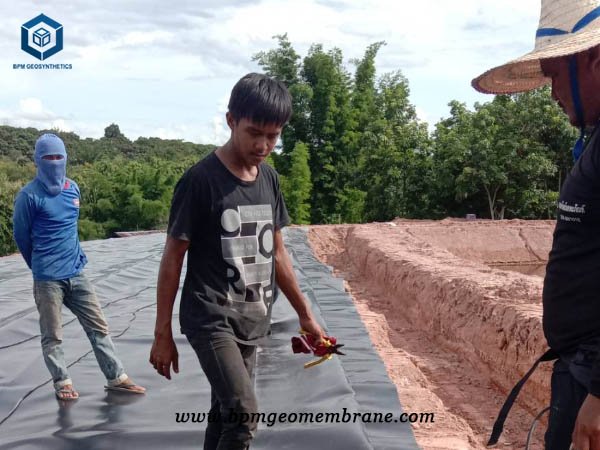
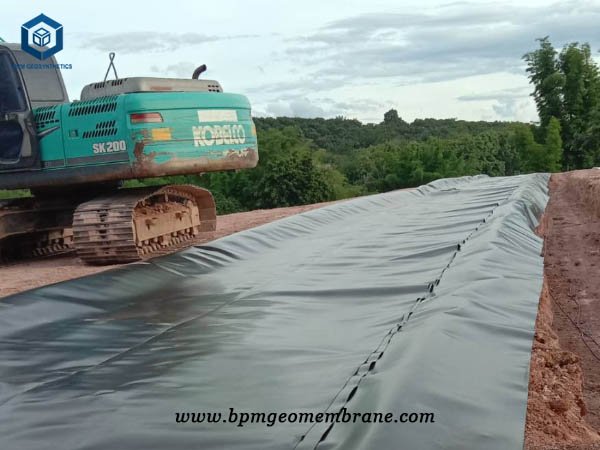
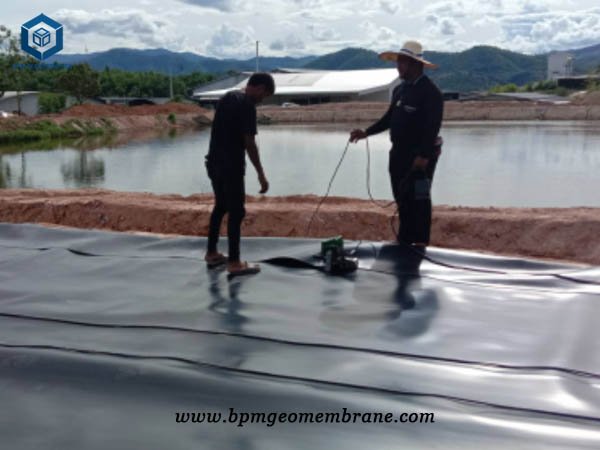
3. What are the benefits of Best Pond Liner Material?
The benefits of using the best pond liner material, such as HDPE, are numerous. HDPE pond liners offer a range of advantages that make them suitable for various applications. They are chemically resistant, ensuring that they can withstand exposure to different liquids and substances. Additionally, HDPE pond liners are highly durable, capable of withstanding wear and tear over time. They are also UV stable, meaning they can endure prolonged exposure to sunlight without degradation or damage. This UV stability eliminates the need for soil cover in exposed lining projects, making HDPE liners cost-effective.
The robust chemical resistance of HDPE pond liners makes them an ideal choice for applications like landfills, wastewater treatment lagoons, animal waste lagoons, and mining sites. The liners can be seamlessly bonded using welding techniques such as wedge or fusion welding, ensuring a secure and reliable lining system.
In the aquaculture industry, the best pond liner materials have gained popularity, especially in Thailand and Southeast Asia, for constructing biogas digesters. These liners, also known as HDPE geomembrane biogas digesters or covered lagoons, provide a reliable and impermeable barrier for fermentation and gas storage. They offer simple and convenient construction, low cost, effective sewage treatment, good sealing performance, high biogas production, and strong resistance to aging, corrosion, and temperature changes.
Overall, the best pond liner materials, such as HDPE, provide a range of benefits, including chemical resistance, durability, UV stability, and cost-effectiveness. Their versatility and reliability make them suitable for various applications, ensuring efficient and long-lasting pond or containment solutions.
In comparison, the biogas digester which is covered by the black best pond liner is the lowest cost form. The scientific name “total enclosed aversion” HDPE pond liner biogas digester project can also save fertilizer costs. Thai customers chose to use the BPM brand environmentally friendly American standard black best pond liner material according to their requirements. The thickness of the upper layer must be more than 1.5mm, and the bottom membrane and sedimentation tank are 1.0mm.6/
4. How To Select Best Pond Liner Thailand for Biogas Digesters Project?
The selection of the best pond liner material for biogas digesters in Thailand holds significant importance due to various reasons.
Firstly, effective gas containment is essential for biogas digesters. These systems collect and store biogas generated from organic waste. A high-quality and impermeable pond liner material acts as a crucial barrier, preventing the escape of biogas into the environment. By choosing an appropriate pond liner, gas containment is optimized, maximizing the potential for biogas production.
Secondly, biogas digesters play a vital role in environmental protection. Methane, a potent greenhouse gas, is captured and utilized in these systems, contributing to the reduction of greenhouse gas emissions. A reliable pond liner material prevents the seepage of biogas, minimizing its release into the atmosphere. This helps in mitigating the environmental impact and supports sustainable waste management practices.
Additionally, longevity and durability are key considerations for biogas digesters. These systems are long-term investments, and the chosen pond liner material significantly affects their structural integrity and lifespan. Opting for a robust and resistant material, such as high-density polyethylene (HDPE), ensures that the digester remains reliable over an extended period. This reduces maintenance requirements and lowers the costs associated with replacements or repairs.
Chemical resistance is another crucial factor when selecting a pond liner material. Biogas digesters contain various organic compounds and potentially corrosive gases. Choosing a pond liner that exhibits excellent chemical resistance is vital to withstand the aggressive substances present in the digester. This prevents degradation, leaks, and potential damage to the surrounding environment.
Considering cost-effectiveness is essential in biogas digester projects. Selecting the best pond liner material that meets the specific requirements in Thailand ensures long-term cost efficiency. A reliable pond liner minimizes the risk of leaks, repairs, and premature replacements. This, in turn, reduces maintenance expenses and maximizes the return on investment for the biogas digester project.
Furthermore, compliance with regulations is crucial to avoid legal issues or penalties. Thailand likely has specific regulations and standards concerning biogas digesters and their components. Choosing a pond liner material that complies with these regulations ensures adherence to the established guidelines and promotes a smooth and lawful operation of the digester.
In conclusion, the selection of the best pond liner material for biogas digesters in Thailand is vital for effective gas containment, environmental protection, longevity and durability, chemical resistance, cost-effectiveness, and compliance with regulations. By considering these factors, the successful and sustainable operation of biogas digesters can be ensured, leading to efficient waste management practices and a reduction in greenhouse gas emissions.
5. Specifications of Best Pond Liner Material for Biogas Digesters in Thailand
The best pond liner material for biogas digesters in Thailand typically has the following specifications:
1. HDPE Pond Liner Thickness: The recommended thickness options for the pond liner material are 0.75 mm and 1.0 mm. These thicknesses provide a balance of durability and flexibility required for biogas digester applications.
2. Total Quantity: The required quantity of the pond liner material is 26,000 square meters. This quantity is determined based on the size and dimensions of the biogas digesters to be constructed.
3. Roll Size: The pond liner material is available in rolls with specific dimensions. The roll sizes specified for this project are 7×210 meters and 7×140 meters. These dimensions are convenient for installation and ensure sufficient coverage for the required area.
4. Standard: The specified standard for the best pond liner material is ASTM GM13. This standard ensures that the material meets the necessary quality and performance requirements for biogas digester applications, ensuring reliability and longevity.
1.0mm HDPE pond liner material will provide the desired properties, such as impermeability, durability, and resistance to aging and corrosion, necessary for the successful construction and operation of biogas digesters in Thailand.
6. Conclusion
Best pond liner for biogas digesters is crucial as it enables effective gas containment, safeguards the environment by preventing biogas seepage, enhances the longevity and durability of the digester, exhibits chemical resistance against corrosive substances, promotes cost-effectiveness by minimizing maintenance and replacement costs, and ensures compliance with regulations. Opting for the best pond liner material guarantees optimal performance and sustainability of biogas digesters, thereby facilitating efficient waste management and reducing greenhouse gas emissions.
BPM Geomembrane recommend 1.00mm HDPE pond liner for or biogas digesters in Thailand. Any questions, please contact us.

